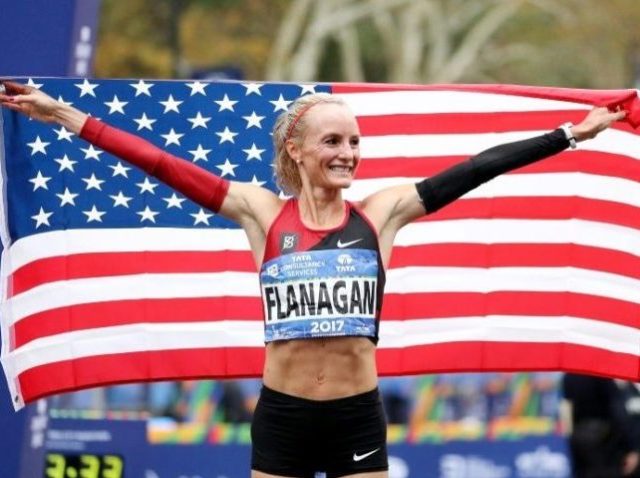Shalene Flanagan made American long-distance runners great again on Sunday.
The Marblehead, Massachusetts-bred runner, in what she indicated might be her last race, won the New York City Marathon. In doing so, the 36-year-old Olympic medalist became the first American woman since Miki Gorman in 1977 to win New York.
American runners endured some rough, out-in-the-wilderness years. So did New York. It took longer for American long-distance runners to win again than it took for New York to do so. But 40 years, a long time in any city, passed as an especially long, and occasionally painful, era in New York between 1977 and now.
Abe Beame back then served as mayor, a job whose description involved staving off bankruptcy and begging for a bailout. Two years previous, President Gerald Ford told the city to “drop dead” when Beame came to him hat in hand. Well, the president did not actually say that—the New York Daily News merely said on its front page that he had said that. But the president’s press secretary did call the financial predicament “a self-inflicted act by the people who have been running New York City.”
A few weeks before the last time an American woman won New York, Howard Cosell famously uttered the words he never actually uttered: “Ladies and gentleman, the Bronx is burning” (New York chroniclers play ventriloquist from time to time). In the summer that preceded Miki Gorman winning, the lights went out and the looters came out. ConEd weakly labeled the former “an act of God”; nobody could mistake the latter as anything but acts of man.
Son of Sam terrorized the city in 1977 until the cops, and a parking ticket, caught up to him. George Steinbrenner terrorized Billy Martin, who terrorized Reggie Jackson, who terrorized any pitcher in an opposing uniform. At least New York had the Yankees going for it. Oh, yeah, and crooners still sang songs about the city—except, instead of Frank Sinatra romantically rhapsodizing about waking up in a city that never sleeps, Mick Jagger, writing in 1977, told his audience: “Go ahead, bite the Big Apple, don’t mind the maggots.” In the late 1970s, “New York, New York” (1977) captured an imaginary, bygone city; “Shattered” (1978) held a mirror up to the face of the actual place.
Not everybody in late-1970s Brooklyn worked deadend paint-store jobs to subsidize their weekend escapes and excesses at the disco. But one gets the impression that 1977’s Saturday Night Fever more closely approximates that time and place than today’s StuffWhitePeopleLike.com does. How does a borough go from Tony Manero to Hannah Helene Horvath in less than a lifetime?
The New York that Miki Gorman ran through was not the New York of Breakfast at Tiffany’s or When Harry Met Sally. And the New York that Shalene Flanagan ran through was not the gritty Gotham of Fort Apache, the Bronx and The Warriors and Taxi Driver and Midnight Cowboy and Death Wish.
New York has suffered through Central Park rapists and a “headless body in a topless bar” and 9/11 and a psycho motorist mowing down cyclists since then. But you can now safely walk through Central Park at night and uncover your kid’s eyes in Times Square during the day. Harlem has morphed from a terrible place to die to a great place to dine. The grim Commodore Hotel became the grand Grand Hyatt. Places such as Hell’s Kitchen and the Bowery then looked like their names. Now they look like places you cannot afford.
It’s been a marathon of a comeback — for a city and the American women who run its streets every autumn.

COMMENTS
Please let us know if you're having issues with commenting.